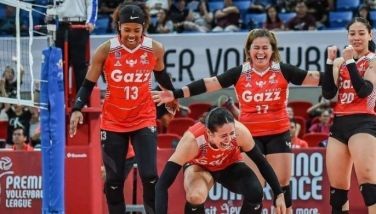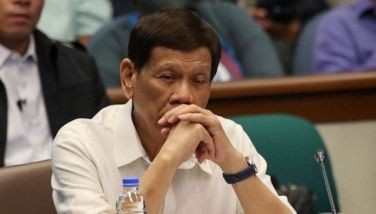Death of the MBA?
July 29, 2002 | 12:00am
The MBA, as we know it, is gone. The operating Multi-Regional Basketball, Inc. or MRBI, has finally stopped the economic hemorrhaging by ceasing its current National Phase.
It was an open secret that players’ salaries had gone unpaid since end of April or early May. Some teams had, in fact, already decided to stop playing until their back wages had been paid to them. But very few were as lucky to have found alternative livelihoods as Chris Clay, who has been forced by circumstances to seek employment as an import for Sta. Lucia Realty in the PBA.
What went wrong? Painfully, the MBA did not have the economic muster to keep up with its monstrous expenses. The league has spent millions of pesos in annual travel costs alone. Its regional format necessitated shipping the teams to and from at least eight different locations all over the archipelago; and even the scheduling of double-headers was not enough to stem the bleeding.
Secondly, the league was unable to hit its sales and marketing targets. Last year, the MBA needed a minimum of P250 million to break even. With its prodigious cost-cutting efforts this season, it still needed well over half that amount to sustain itself. And it faced the chicken and egg situation of whether to mount a sustained television coverage on the gamble that this would bring in the revenue, or forego the coverage to cut down costs and find alternative sources of income.
On paper, the new plan of centralizing operations was supposed to work. However, in reality, if not every team pulled in the P15 million or so needed to hold up its end, then the concept would fail.
Third, the MBA inherited the massive salaries from its earlier marriage to ABS-CBN. It still had to honor the PBA-sized fees to a handful of superstars, an ill-advised shortcut to the growth process enforced largely by the network.
Lastly, it is the very regional nature of the MBA that has been its double-edged sword, both its lifeblood and its open wound. Its market consists of the long-neglected basketball hotbeds in the southern Philippines, but the very travel that makes it possible was the biggest, most crippling cost.
So what will the MBA do now?
The league has several options. The first would be to shut down and re-open as a totally different corporate entity. This would be a convenient escape from the responsibility of paying the millions it owes its players and employees. But many believe that this would be unlikely, given the reputation of the principal players running the MBA, all competent business owners known for their integrity and forthrightness.
The merger with the Philippine Basketball League looms as a remote possibility, but, as I’d written previously, the PBL itself is uncomfortable even with the term "merger". Given the latest developments, the amateur league could even argue that there is nobody to merge with.
The more viable MBA teams - such as the LBC Batangas Blades, Cebuana Lhuillier Gems, The Professional Davao Eagles and the Pampanga Stars - could try to enter the PBL, but Welcoat Paints and Tanduay Rhum are mulling a comeback. Besides, some of the corporations backing MBA teams have rivals in the PBL, which might make it more difficult for them to get in.
The wild card in all of this is RFM. The Concepcions have the clout to make a unification of sorts happen. Where they cast their lot will definitely influence the future of the MBA.
Most probably, the MBA will find a way to scale down its operations and still maintain some regional flavor. How many of its current crop of players it can accommodate under this new scheme is not yet clear.
The nagging question is this: what will happen to the salaries of the league’s players, technical officials and office personnel? Will they be paid in full, or will they be offered buy-outs at a fraction of what was due them? It might be helpful to study the Bong Hawkins case. When FedEx acquired the Tanduay franchise, the All-Star forward did not want his contract restructured. So he preferred to sit out the season and draw his mandatory salary from the team. This seems improbable, because this would be the very staggering expense the MRBI is avoiding, and they would derive no profit from paying the players’ contracts now that there is no league running.
Instead of looking at the MBA scenario as a financial disaster, one could, instead, consider it a grand opportunity for the league’s officers to exhibit their greatness. If their concern for their players and employees is paramount, then they will come out of this situation with their reputations intact. Very few of its players went in to past PBA drafts and can return as free agents. Besides, they will have a tough time cracking current rosters, already overloaded with Fil-Ams and imports. Its own Fil-Ams will likewise need to go into the draft, unless they miraculously can be hired as imports like Clay.
If, however, they try to slink away from their responsibilities, then the public perception of their companies will be greatly tarnished. Who would want to be associated with a company that contributed to the starvation of dozens of families?
In the meantime, the MBA’s prime responsibility is to ensure the economic stability of its on- and off-court personnel, whether it means placing them elsewhere or paying them as soon as possible. The goodwill this will engender will go a long way in keeping the flame of hope that the dream that has been the MBA will not die.
It was an open secret that players’ salaries had gone unpaid since end of April or early May. Some teams had, in fact, already decided to stop playing until their back wages had been paid to them. But very few were as lucky to have found alternative livelihoods as Chris Clay, who has been forced by circumstances to seek employment as an import for Sta. Lucia Realty in the PBA.
What went wrong? Painfully, the MBA did not have the economic muster to keep up with its monstrous expenses. The league has spent millions of pesos in annual travel costs alone. Its regional format necessitated shipping the teams to and from at least eight different locations all over the archipelago; and even the scheduling of double-headers was not enough to stem the bleeding.
Secondly, the league was unable to hit its sales and marketing targets. Last year, the MBA needed a minimum of P250 million to break even. With its prodigious cost-cutting efforts this season, it still needed well over half that amount to sustain itself. And it faced the chicken and egg situation of whether to mount a sustained television coverage on the gamble that this would bring in the revenue, or forego the coverage to cut down costs and find alternative sources of income.
On paper, the new plan of centralizing operations was supposed to work. However, in reality, if not every team pulled in the P15 million or so needed to hold up its end, then the concept would fail.
Third, the MBA inherited the massive salaries from its earlier marriage to ABS-CBN. It still had to honor the PBA-sized fees to a handful of superstars, an ill-advised shortcut to the growth process enforced largely by the network.
Lastly, it is the very regional nature of the MBA that has been its double-edged sword, both its lifeblood and its open wound. Its market consists of the long-neglected basketball hotbeds in the southern Philippines, but the very travel that makes it possible was the biggest, most crippling cost.
So what will the MBA do now?
The league has several options. The first would be to shut down and re-open as a totally different corporate entity. This would be a convenient escape from the responsibility of paying the millions it owes its players and employees. But many believe that this would be unlikely, given the reputation of the principal players running the MBA, all competent business owners known for their integrity and forthrightness.
The merger with the Philippine Basketball League looms as a remote possibility, but, as I’d written previously, the PBL itself is uncomfortable even with the term "merger". Given the latest developments, the amateur league could even argue that there is nobody to merge with.
The more viable MBA teams - such as the LBC Batangas Blades, Cebuana Lhuillier Gems, The Professional Davao Eagles and the Pampanga Stars - could try to enter the PBL, but Welcoat Paints and Tanduay Rhum are mulling a comeback. Besides, some of the corporations backing MBA teams have rivals in the PBL, which might make it more difficult for them to get in.
The wild card in all of this is RFM. The Concepcions have the clout to make a unification of sorts happen. Where they cast their lot will definitely influence the future of the MBA.
Most probably, the MBA will find a way to scale down its operations and still maintain some regional flavor. How many of its current crop of players it can accommodate under this new scheme is not yet clear.
The nagging question is this: what will happen to the salaries of the league’s players, technical officials and office personnel? Will they be paid in full, or will they be offered buy-outs at a fraction of what was due them? It might be helpful to study the Bong Hawkins case. When FedEx acquired the Tanduay franchise, the All-Star forward did not want his contract restructured. So he preferred to sit out the season and draw his mandatory salary from the team. This seems improbable, because this would be the very staggering expense the MRBI is avoiding, and they would derive no profit from paying the players’ contracts now that there is no league running.
Instead of looking at the MBA scenario as a financial disaster, one could, instead, consider it a grand opportunity for the league’s officers to exhibit their greatness. If their concern for their players and employees is paramount, then they will come out of this situation with their reputations intact. Very few of its players went in to past PBA drafts and can return as free agents. Besides, they will have a tough time cracking current rosters, already overloaded with Fil-Ams and imports. Its own Fil-Ams will likewise need to go into the draft, unless they miraculously can be hired as imports like Clay.
If, however, they try to slink away from their responsibilities, then the public perception of their companies will be greatly tarnished. Who would want to be associated with a company that contributed to the starvation of dozens of families?
In the meantime, the MBA’s prime responsibility is to ensure the economic stability of its on- and off-court personnel, whether it means placing them elsewhere or paying them as soon as possible. The goodwill this will engender will go a long way in keeping the flame of hope that the dream that has been the MBA will not die.
BrandSpace Articles
<
>
- Latest
- Trending
Trending
Latest
Trending
Latest
Recommended
































